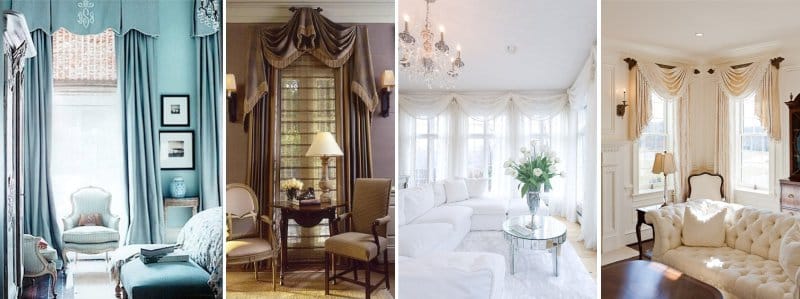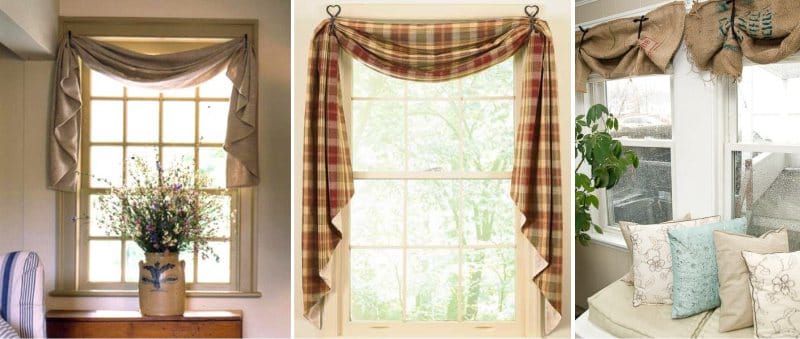Lambrequins for the kitchen help to hide the cornice and fasteners. But their purpose is not only practical, but also decorative. Before you sew such curtains with your own hands, you need to choose the right material for them - textiles for the kitchen must be different for fire safety, do not absorb odors and do not accumulate dust.
Features of pelmets

So, what is a pelmet? This is an elegant element of curtains, invented by the French. It is a drapery at the top of the window opening, in essence, being a shortened curtain located horizontally. It can be sewn from dense fabric, forming a pleating, and brushes, borders, and frills are chosen as additional decorations.
Curtains with lambrequins are not standard textiles, but a more complex combination of fabrics and draperies. Lambrequin is best suited for classic interiorall country styles (country, Provence, shabby chic, rustic) and luxurious art deco style.

- But keep in mind that lambrequins of complex cut from heavy noble fabrics, with a lot of draperies, metal molds, bells and other decorations are created for living rooms, bedrooms and dining rooms. For kitchens of standard sizes up to 15 square meters. m such models do not fit.

- The smaller the kitchen - the easier and more concisely there should be pelmet and curtains.
Curtains with lambrequin will make the room more solemn and expressive. In addition, they can visually change the proportions of the window opening, stretching it or narrowing it.
Varieties of lambrequins
There are more than 25 varieties of this type of curtain. Here are some of them.

Conventionally, all these species can be divided into three general groups:
- Hard type allows you to effectively decorate the top of the window. In addition, with its help, the cornice and the upper pier are remarkably hidden. By construction, a rigid lambrequin is a narrow fabric strip on the seal, fixed under the ceiling. A hard lambrequin can vary in shape - there are oval, rectangular, complex shapes. In addition, the hard type of construction is additionally decorated with cords or ribbons, fringe, draperies.


- The soft type is highly decorative. For these draperies are special patterns. As for the material, the tailoring of the soft lambrequin with your own hands can be made of a fabric identical to curtains, or a completely contrasting material. Before you cut the material, determine its length - it is 15-25% of the length of the curtains.




- The hands can sew and combined. This decorative detail combines the rigidity of the base and the softness of the drape. It looks most harmonious in rooms with large windows.


Decorative items
To sew your own curtains with the lambrequins of your dreams, for example, in a spacious kitchen with large windows, kitchen-living room or in the dining room, you can choose one of the spectacular decorative elements:

- Swag - a semicircle draped with the help of folds; the shell, located horizontally, can be made symmetrical or not;
- The de jabot is a side element, a “jabot” with a lower bevel (or located in steps), thanks to the de jabot a rigid or soft lambrequin acquires a vertical;
- A tie is an element with pleats cut along the top;
- Kokilje - flared assembly in the center, which is located, as a rule, in the center of the pelmet between two svagami.
How to start sewing
Of course, tailoring lambrequin requires patterns. And she, in turn, is created on the basis of the basic design concept. In addition, practical feasibility is also taken into account - it should be convenient to use curtains.
If you have no experience or your kitchen has a small area of 5-15 square meters. m, it is better to prefer sewing a simple model. Do you want to experiment and sew a lambrequin with a chill, swag and bells? Then you will need complex patterns not only for the lambrequin itself, but also separate patterns for decorative assemblies.
If you have little experience in sewing, then before you begin to sew and cut the pelmet of the desired fabric, practice first on the old bed linen.
How to choose the fabric for pelmet and to combine it with curtains? The material for it can be used the same from which the curtains are sewn, or choose a fabric that will be thicker than the curtains. By color, it is desirable to choose a material either in tint or darker curtains.

How to sew a pelmet with tails
Multi-component patterns should be left to professionals, and the simplest pelmet with tails will be available even for beginners. By the way, it is wonderfully combined with light kitchen tulle, jalousie or roman blinds.

Before you cut the material, you need to pick up all the necessary elements:
- Facial tissue and lining (desirable);
- Gasket for laying - most often, flizelin, gang or dublerin (if desired);
- Eaves rod or wooden plank 5 cm wide, about 2 cm thick, the length is calculated from the calculation: the length of the window plus 20-30 cm;
- 1 m of decorative cord;
- 0.5 meter tape;
- Stapler with staples or a hammer with nails;
- Marking pencil;
- Screwdriver;
- Screws;
- Drill.
So, we proceed to work:
- We attach the bar or the cornice - 100 mm above the window frame, and so that the ends protrude beyond the window by 100-150 mm.

- Now you need to cut and iron the material.

The length of the fabric corresponds to the length of the cornice + 10 for the "tails". For lambrequin, sagging 50 cm, you will need 70 cm width of the canvas. Patterns must also include seam allowances - 15 mm on each side.

- Lining fabric is cut in the same way.
The use of the lining will provide the volume of the product, texture and softness of its folds.
- The lining fabric is smoothed, and the main one is placed on top. Before starting sewing, all layers of the structure are fastened with pins. Fabrics are stitched so that 30 cm is left blank.

- Pins are removed. In the corners, small cuts are made across.

- The fabric is turned out and ironed. The not stitched hole is sewn up manually.

- The middle of the lambrequin is attached to the central part of the slat, after which the entire fabric is fixed on the slat - so that its ends hang loosely.
- These ends are tied with a decorative cord, after which the cord is tied with a bow. On this tailoring simple, but at the same time the original and stylish lambrequin for the kitchen, is finished.
And here are other ideas on how to make your own hands simple in the manufacture of pelmets for the kitchen.




- Curtains for the kitchen: color, material, look and style
- Curtains-threads in the kitchen - the choice, care, making their own hands
- How to choose curtains for the kitchen with a balcony door - 4 solutions
- Everything you need to know about kitchen tulle
- How to choose the perfect short curtains for the kitchen
- Knitted curtains for the kitchen



 (Rate the material! Already voted:12 average rating: 4,67 from 5)
(Rate the material! Already voted:12 average rating: 4,67 from 5)